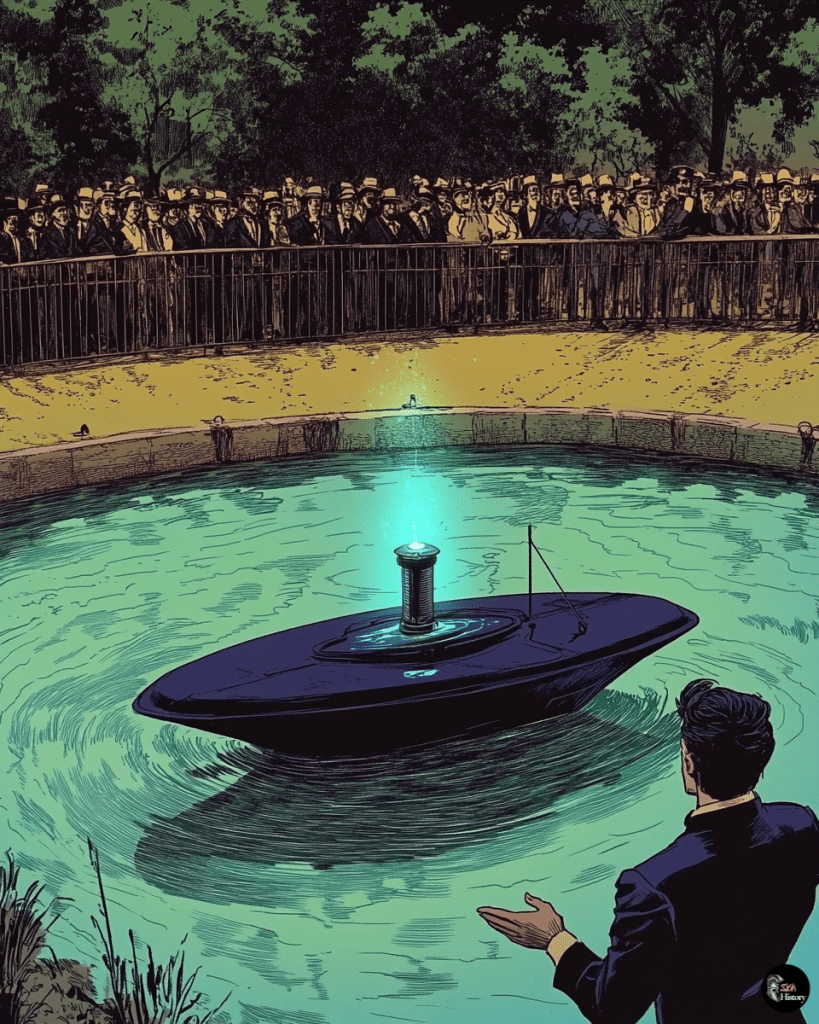In the twilight of the 19th century, as the world teetered on the brink of a new technological era, Nikola Tesla unveiled an invention that would leave spectators spellbound and skeptics scratching their heads. The year was 1898, and the stage was set at Madison Square Garden’s Electrical Exposition. Little did the audience know they were about to witness the birth of remote-control technology.
The Telautomaton Unveiled
Tesla, the enigmatic Serbian-American inventor, had crafted a marvel called the “telautomaton” – a radio-controlled boat that danced to invisible waves. As the crowd gathered around a small indoor pond, Tesla stood proudly beside his creation, a gleaming vessel no larger than a child’s toy, measuring just four feet long and three feet high.
A Demonstration of Magic
With a flourish that would make any magician proud, Tesla began his demonstration. The boat glided through the water, its lights blinking, rudder turning, and propeller spinning – all without a single visible connection to its master. The audience gasped in amazement. Scientists leaned forward in their seats, investors’ eyes widened with possibility, and the general public whispered in awe.
Skepticism and the Monkey Theory
But as with any great magic trick, some refused to believe their eyes. Skepticism rippled through the crowd. One particularly dubious observer, his mind unable to grasp the concept of wireless control, loudly proclaimed that there must be a trained monkey hidden within the boat’s hull, frantically operating levers and switches.
A Revolutionary Concept
The idea of a simian stowaway controlling the boat from within might seem comical to us now, but it speaks volumes about the revolutionary nature of Tesla’s invention. In a world where the horse-drawn carriage was still king, the notion of controlling a machine from afar was so foreign that some found it easier to believe in a hidden primate than in the power of radio waves.
Disbelief in High Places
Even the military, always on the lookout for the next game-changing weapon, couldn’t wrap their heads around Tesla’s creation. When the inventor attempted to present his telautomaton to a military officer, hoping to showcase its potential for unmanned warfare, he was met with derisive laughter and dismissive disbelief.
The Patent Examiner’s Journey
Skepticism reached such heights that the chief patent examiner felt compelled to travel from Washington, D.C., to New York in November 1898. He had to see this supposed marvel with his own eyes before he could even consider approving Tesla’s patent application. Upon witnessing the boat’s uncanny movements, the examiner’s doubts evaporated, and Tesla’s patent was swiftly granted.
Beyond a Parlor Trick
What set Tesla’s invention apart was its ability to distinguish between multiple signals, allowing for complex control that far surpassed existing single-frequency systems. This was more than just a parlor trick; it was the dawn of a new age in human-machine interaction.
However, for Tesla, telautomaton was merely the beginning. In his grand vision, this small boat was the harbinger of a “race of robots” that would one day shoulder the burden of humanity’s most laborious tasks. Little did he know how prophetic his words would prove to be.
The Legacy of Innovation
As we look back on that day in Madison Square Garden, we’re reminded of the power of imagination and the importance of pushing beyond the boundaries of what seems possible. Tesla’s enchanted boat, navigating both water and waves of disbelief, didn’t just demonstrate the principle of remote control – it opened our eyes to a future where the impossible becomes routine.
In an age where we casually control our homes, cars, and countless devices with the touch of a button or our voice, it’s worth remembering the day when such an idea seemed so fantastical that a hidden monkey seemed more plausible than invisible waves. Tesla’s legacy lives on, not just in the technology we use every day, but in the spirit of innovation that continues to push humanity forward, one incredible invention at a time.

